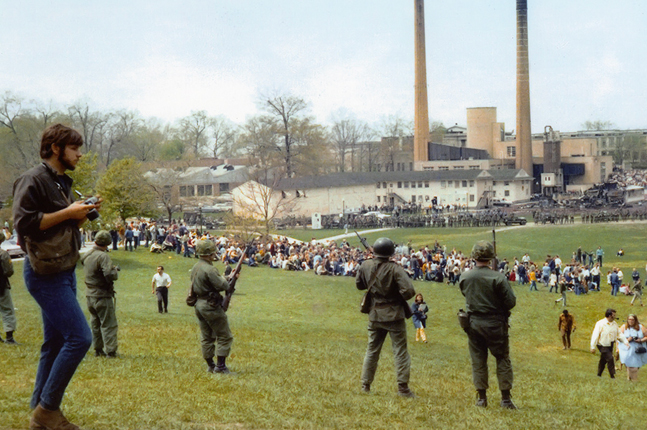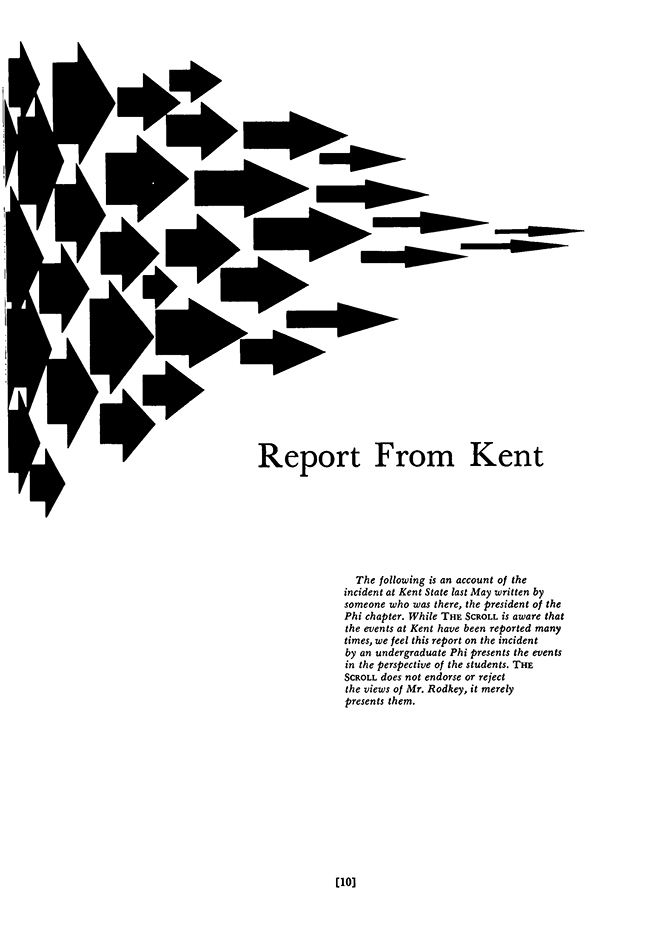
Vietnam War and Campus Unrest Challenge Greek Community
1970From In the Bond
The undeclared war in Vietnam created serious rips in the fabric of American society during that conflict in a way no previous military action ever had.
The unpopular war contributed to a generation gap that has never completely faded away, although the conflict itself was terminated in the 1975–76 period.
Because the ranks of the protesters were dominated by young people, there was a potential threat to the survival of the fraternity system.
To get at the root of campus unrest, one has to look at the surprising increase in the number of college students during the generation of the 1960s. In 1969 there were more than 9,000,000 full-time students across the country, nearly twice the student population at the start of the decade.
This was an activist generation concerned about the draft, the war, politics, and race relations. As Havighurst phrased it, “concerned more about today and tomorrow than yesterday.”
There was seemingly little respect for age, authority, or tradition. The activists were quick to defy academic authority and took over campus buildings and administrative offices at many schools.
After several years of campus violence and disruption, the ultimate confrontation will go down in American history, simply remembered as ‘Kent State.’
The anti-war protests were loud and sustained on the campus of the state school in northeastern Ohio. Triggered by the U.S. bombing of neutral Cambodia, thus spreading the Asian conflict, Kent State students demonstrated out of control for three nights, putting a severe strain on campus and city police.
Headlines across the nation blared “rioting students bum campus ROTC building.“ That was true, but the stories did not point out that the ROTC building was a Quonset hut and not part of the university’s permanent structures.
Ohio Governor James A. Rhodes was asked to intervene and dispatched a unit of the state’s national guard to restore order. When the troops arrived on the morning of May 4, 1979, dissident students passed out flyers calling for a “Rally at the Commons at noon.”
The rally turned tragic. The guardsmen, in full gear, were in formation up a hill overlooking the Commons where paths to various buildings intersected.
Matters got out of hand. The citizen soldiers had never had training in the control of unarmed civilians. Many of the students showed up to be spectators rather than participants. As the troops came down the hill in formation, some of the braver demonstrators, tragically more rash than brave, started to pelt them with rocks and other debris.
When the first shots were fired, the student mob began to scatter in all directions. But four students lay mortally wounded. The picture of their friends trying to comfort them was flashed around the world. Four students were dead, and nine were wounded.
For months state and federal commissions were trying to assess blame for the tragedy, but in the final analysis, there was no answer.
A member of Ohio Lambda wrote in a letter to The Scroll (regarding the inquests), “The answers they are going to get center around President Nixon’s escalation of the war by sending troops into Cambodia.
“Other reasons will include the absence of democracy in our so-called democratic system of government and the refusal of college and university administrations to listen to the questions and suggestions of their students.”
Although fraternity membership declined in the late 1960s, when Greek letters were considered supportive of the old order, the damage to the fraternity system was much less than one would have suspected.
Bob Miller was executive vice president of the Fraternity all through the troubled era and, in looking back, has some interesting thoughts.
“When anyone asks me about Vietnam, I ask them to define which years they are talking about,” Miller says. “The war lasted over a decade, and concerns were different at different times.
“It was a difficult period, but overall, Phi Delta Theta held its own, as did most of the larger and well-established Greek letter societies. We did lose a few chapters, but we managed to replace them, mostly at newer institutions.”
Miller surveyed chapters and members through the 1960s for this book. He discovered there were 119 active chapters in 1962, and that number had grown to 141 chapters and nine colonies a decade later in 1972.
“I don’t mean to indicate these weren’t difficult tunes,” Miller went on. “There were problems everywhere that called for different actions. We had more problems on the East and West Coasts. Fraternities in the tradition-oriented South carried on as usual most of the time.”
What Miller did see was a decline in the number of Phi Deft leaders in both the ranks of the younger alumni and in chapters on campus.
“By 1972, the worst was over, but fraternities, and I think all fraternities, were slow to adjust to the new demands of getting the system back to its older basic ways.
“We observed chapters that had forgotten how to rush, how to administer their affairs, often including their financial affairs,” Miller summed it up. “The general objective was to build bridges back to the original standards.”
Read the Report From Kent State from the September 1970 edition of The Scroll

